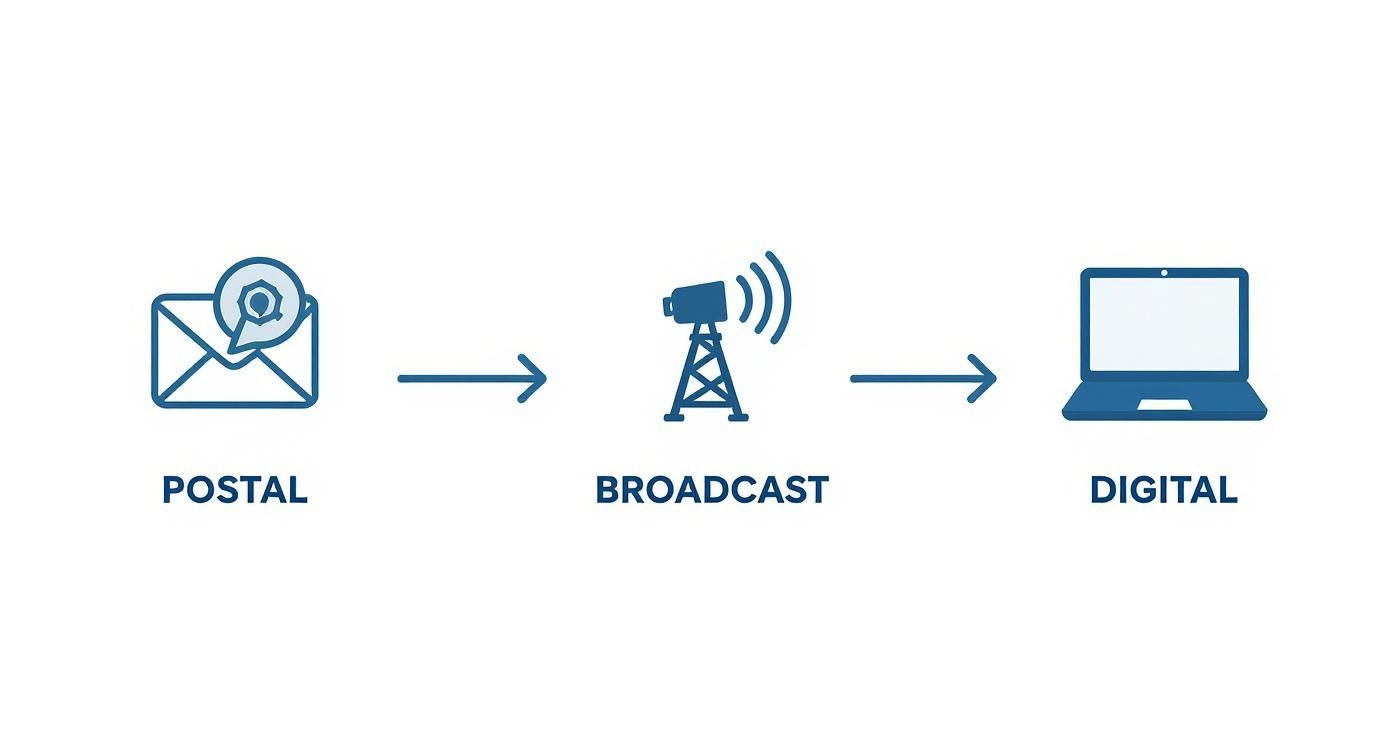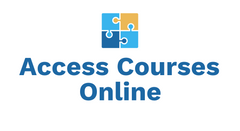Think of distance learning as education that fits around your life, not the other way around. It’s a way to earn qualifications without ever stepping into a traditional classroom. Instead of a daily commute to campus, you use technology to connect with your course materials, chat with tutors, and work alongside your classmates—all from wherever you happen to be. It’s this flexibility and accessibility that makes it such a powerful option for so many people.
What Does Distance Learning Actually Mean Today?
At its heart, distance learning is simply education without the geographical chains. Imagine a classroom without any walls, where the internet is the bridge connecting you to your tutors and your course. It’s far more than just watching a few pre-recorded videos and hoping for the best. Modern distance learning is a fully interactive experience, blending different methods to guide you on a clear, structured educational journey.
The real magic of this model is how it adapts to you. It’s built for anyone trying to juggle studies with a job, family, or other commitments, making higher education and career progression a realistic goal for people from all walks of life.
The Key Ingredients of Modern Distance Learning
So, what makes it all tick? Today’s distance learning is built on a few core pillars that ensure it’s not just a convenient alternative, but an effective and engaging one too. It doesn't just try to copy a physical classroom online; it uses technology to create a unique and often more personalised way to learn.
Let's break down what that looks like in practice.
Distance Learning at a Glance
To really get a feel for how it all works, it helps to see the main components laid out. This table summarises the essential elements that define the modern distance learning experience.
| Component | Description |
|---|---|
| Technological Platforms | Your online "campus," usually a Learning Management System (LMS) where you'll find everything from lecture notes to assignment drop-boxes. |
| Separation of Learner and Tutor | You and your instructors are in different places, so communication happens through tools like email, video calls, and forums. |
| Flexible Pacing | Many courses let you work through materials on your own schedule (within deadlines), perfect for fitting study around a busy life. |
| Interactive Communication | It’s not a solo journey. You’ll stay connected with tutors and fellow students through online discussions and group projects. |
These elements come together to create a supportive and structured digital environment where you can truly thrive.
Essentially, modern distance learning is built on these key ideas:
- A Central Online Hub: This is your home base, often a platform called a Learning Management System (LMS). It’s where you’ll find all your course materials, submit your work, and see how you’re progressing.
- Tutors and Students in Different Places: Because you’re not in the same room, digital tools are used for all your communication and support needs.
- Study at Your Own Pace: A lot of courses are 'asynchronous', which is a fancy way of saying you can study when it suits you, as long as you meet the deadlines. It's a game-changer for anyone with a packed schedule.
- Keeping Connected: Learning is a social activity, even online. You’ll use everything from email and video calls to online discussion boards to stay in touch with your tutors and classmates, so you never feel like you're going it alone.
From Postal Courses to Digital Classrooms
To really get what distance learning is all about today, it helps to take a quick look back at where it started. The idea itself isn't new at all; it began over a century ago with what were called correspondence courses or 'postal tuition'. Students would get their lessons and assignments in the post, do the work, and mail it all back to be marked. Simple, but effective.
This was the very first version of learning on your own schedule, opening up education for anyone who couldn't physically get to a college or school. As technology moved on, so did the methods. First came radio and television, beaming educational programmes straight into people's living rooms and making learning accessible on a massive scale.
From Broadcast to Broadband
But the real game-changer? The internet. This completely turned distance education on its head, taking it from a slow, paper-based exchange to the instant, interactive experience we know today. It’s what connects students and tutors in a way that just wasn’t possible before.
This timeline gives you a great visual of how far things have come.

As you can see, every technological jump—from the postman to the web browser—has cranked up the speed and interaction, making remote education a completely different beast.
This journey has been shaped by a few key developments:
- Learning Management Systems (LMS): Think of these as your online campus. They’re digital hubs that keep everything organised, from your course materials and video lectures to submitting assignments and checking your grades.
- Video Conferencing Tools: Platforms like Zoom and Microsoft Teams have made live, face-to-face tutorials a normal part of the deal. It means you can have proper group discussions and you don’t feel like you’re studying all alone.
- Instant Communication: With email, forums, and messaging apps, you have a direct line to your tutors and classmates. Getting help or working together on a project is easier than it has ever been.
The heart of distance learning—its flexibility—hasn’t changed one bit. What has changed is the tech that powers it, turning what was once a lonely pursuit into a connected, dynamic way of learning that’s built for modern life.
Understanding How Distance Learning Works in Practice

Distance learning isn’t just one single, rigid method. It’s actually a really flexible approach with a few different models, all designed to fit around different lives and learning styles. The way a course is set up has a massive impact on your day-to-day experience as a student, so it’s worth getting your head around the options before you sign up.
The biggest difference comes down to timing—are you learning in real-time with other students, or are you working through materials on your own schedule? This is what really shapes the rhythm of your studies and how you connect with your tutors and classmates.
Synchronous Learning: The Live Experience
Synchronous learning is the closest you’ll get to a traditional classroom, but online. Everyone logs in at the same time for live lectures, interactive seminars, or group chats. Think of it like tuning into a live webinar—everyone is there together, experiencing it at the same moment.
This model is fantastic for getting instant feedback and having those lively, back-and-forth discussions. It helps build a real sense of community because you get to know your tutors and fellow students in real-time, usually through video calls.
Asynchronous Learning: Your Schedule, Your Pace
On the flip side, asynchronous learning puts you completely in the driver's seat of your own timetable. All the course materials—like pre-recorded lectures, articles, and assignments—are there for you to get stuck into whenever it suits you. It’s a bit like creating your own study playlist; you decide when and where you press play.
With this model, communication tends to happen through forums or message boards, which gives everyone time to think through their responses instead of reacting on the spot. It’s the perfect fit for anyone juggling work, family, or other big commitments. If you’re curious about how these courses are put together, you can find some great insights on instructional design for online courses.
This kind of flexibility is a massive reason why online education has grown so much in the UK. In fact, the market is expected to hit around £5 billion in revenue by 2025. The technology that makes it all possible, especially Learning Management Systems (LMS), is the biggest piece of that pie.
Lots of programmes, including our Access to HE Diplomas, actually use a blend of both. You might have asynchronous modules to work through at your own pace but with the option to join live tutorials if you need a bit of extra support. It’s just one answer to the common question, can you do an Access to Higher Education course online? This blended approach gives you the best of both worlds: freedom and structure.
Weighing the Benefits and Common Challenges

Starting a distance learning course is an exciting mix of freedom and opportunity, but it’s always smart to go in with your eyes wide open. Understanding both the brilliant advantages and the potential hurdles is the first real step towards making a success of it.
More often than not, the benefits boil down to practicality and access. The ability to shape your studies around your life – rather than turning your life upside down for your studies – is a massive draw for so many people.
In fact, the use of digital learning tools among UK students is incredibly high, with approximately 60% using them regularly. A huge 90% of students favour the flexibility and convenience of remote education, which just goes to show how much this perk is valued.
The Advantages of Studying Remotely
The practical upsides are clear, compelling, and for many people, they make education genuinely achievable.
- Unmatched Flexibility: You can study whenever and wherever suits you best. This makes it possible to juggle your course with a job, family, or other commitments. We’ve even got a guide on how online learning fits into your busy lifestyle.
- Greater Accessibility: Suddenly, top-quality programmes are available no matter where you live. Geographical barriers to getting on your dream course are a thing of the past.
- Cost Savings: When you study from home, you can wave goodbye to commuting costs, campus accommodation, and all the other expenses that come with traditional university life. The same logic applies in the workplace, where companies are seeing the benefits of eLearning for employee development.
Facing the Common Hurdles
On the flip side, that freedom and flexibility come with a catch: you need to be the one in charge. Success in distance learning means learning to navigate a few common challenges.
The biggest shift for many is moving from a structured, tutor-led environment to one where you are in the driver's seat. It requires strong self-discipline to stay on track.
Here are a few things to keep in mind:
- Self-Discipline and Time Management: Without a fixed timetable telling you where to be and when, it’s entirely up to you to manage your schedule and hit your deadlines.
- Potential for Isolation: Learning on your own can sometimes feel a bit lonely. That’s why it’s so important to get involved in online forums and make the most of tutorials to connect with others.
- Technology Reliance: A stable internet connection and a reliable computer are your absolute essentials. Technical glitches can happen, and they can be a frustrating bump in the road.
The Tech That Brings Your Course to Life

To really get what distance learning is about today, you have to look at the tools that make it all click. Modern online courses aren't just a collection of PDFs; they're a carefully integrated set of technologies that turn your home into a dynamic, fully-equipped campus.
The heart of this digital world is the Learning Management System (LMS). Think of it as your university’s main building, just online. Platforms like Moodle or Canvas are the central hub where you’ll find everything: course materials, lecture notes, assignment drop-boxes, and your grades. It's your one-stop-shop for all things study-related.
The Tools for Teamwork and Talking
But learning isn't a solo sport. Beyond the LMS, a whole host of other tools are brought in to spark real-time conversation and group work. This is the tech that makes sure you never feel like you're studying in isolation.
- Video Conferencing Platforms: Tools like Zoom and Microsoft Teams have become the new lecture halls and seminar rooms. They host live tutorials, group debates, and one-to-one chats with your tutors, which is vital for building that all-important sense of community.
- Collaborative Software: When it's time for a group project, platforms such as Google Docs or Miro are lifesavers. They let you and your classmates jump into the same document or whiteboard to brainstorm ideas and pull presentations together in real-time, no matter where you are in the world.
These tools don't just mimic a physical classroom; they create an entirely new kind of learning space. It's an organised, accessible, and incredibly interactive environment that's there to support you from day one right through to graduation.
Rounding out the toolkit are more specialised platforms. Digital libraries grant you access to a treasure trove of academic papers and books, while online proctoring services are sometimes used to ensure exam integrity. All these pieces fit together to create a solid, engaging learning experience that easily stands toe-to-toe with traditional campus-based study.
The Growing Role of Distance Learning in UK Universities
Not so long ago, distance learning felt like a niche option in higher education. Now, it’s a cornerstone of how UK universities are planning for a more sustainable and globally competitive future. This isn't just a trend driven by new technology; it’s a smart response to what students actually need and the economic realities universities are facing.
Online programmes are a game-changer, allowing institutions to connect with a much broader audience. Think of working professionals who want to upskill without putting their careers on hold, or international students who dream of a UK qualification without the massive expense of relocating. By breaking down geographical walls, universities are building more diverse and dynamic student communities.
Adapting to a New Educational Climate
The shift towards online learning is also a practical move. With budgets getting tighter and government policies constantly changing, universities are looking for stable ways to grow, and distance learning offers a reliable path forward.
According to the Office for Students, a staggering 43% of UK universities are bracing for budget deficits in the 2024–25 academic year, partly because of shifts in international student numbers. Expanding online courses is one of their key strategies for navigating these choppy waters and securing their long-term stability. You can read more about these online learning developments in UK higher education.
To make it happen, many universities are now teaming up with private ed-tech companies to design and market top-tier online courses. These partnerships blend academic excellence with digital know-how, resulting in learning experiences that are both effective and engaging. It’s clear this is more than just a temporary fix. For many institutions, online learning is the future of education and a core part of how they plan to teach, grow, and succeed for years to come.
Common Questions About Distance Learning
Thinking about distance learning often brings a few practical questions to mind. Getting clear answers can give you the confidence you need to take that exciting next step in your education. Here, we tackle some of the most common queries we hear from people just like you.
Are Distance Learning Qualifications Respected by Employers?
Absolutely. In the UK, a qualification from an accredited institution carries the same weight, whether it was earned online or on-campus. It’s as simple as that.
In fact, many employers now actively seek out the skills that online students naturally develop. Things like brilliant time management, self-discipline, and digital confidence are hugely valuable in any modern workplace. The key has always been the accreditation of the awarding body, not how the course was delivered. A recognised diploma is a recognised diploma.
How Do I Stay Motivated and Avoid Feeling Isolated?
This is a big one, and the answer is all about creating structure and making connections. First, set up a dedicated weekly study schedule. Then, break your work down into small, achievable goals to keep the momentum going. Don't forget to celebrate those small wins along the way – it makes a massive difference!
To keep feelings of isolation at bay, it's so important to get involved with your course community.
- Participate in Forums: Don’t be a lurker! Jump into the online discussion boards. It’s where so much of the real learning and connection happens.
- Join Study Groups: If your course has them, virtual study groups are a fantastic way to collaborate with classmates and feel like you're part of a team.
- Connect During Live Sessions: Use live tutorials to chat with your tutors and other students. Ask questions, share your thoughts, and make the most of that real-time interaction.
What Essential Technology Do I Need to Get Started?
You really don't need a high-tech command centre to start learning online. The essentials are straightforward, and you probably have most of them already.
All you’ll need is a reliable computer (a laptop or desktop is fine), a stable internet connection, and a webcam with a microphone for any live tutorials. Most institutions, including ours, provide access to all the necessary software, so you won’t be hit with unexpected costs.
It’s always a good idea to check the specific technical requirements for your chosen course before you enrol, just to be on the safe side.
Ready to take the next step towards a new career? At Access Courses Online, we provide accredited, flexible diplomas designed to get you to university. Explore our courses at https://accesscoursesonline.com and start your journey today.

